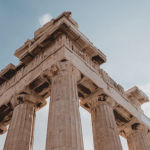Supreme Leader Ayatollah Ali Khamenei has restructured the Islamic Republic’s national security apparatus to cover up Iran’s gaping weaknesses.
What’s old is new again in Iran. Over the course of just one week in August, the Islamic Republic established a new body dubbed the Defense Council, echoing a similarly named entity from the Iran-Iraq War (1980–1988). Overseen and established by the Supreme National Security Council (SNSC) per Article 176 of the Constitution, the Defense Council is already being framed as a “war cabinet” in Iranian media.
That same week, Iran also played musical chairs and re-appointed veteran politician Ali Larijani as both SNSC secretary and representative of the country’s Supreme Leader to the body. Larijani previously served as SNSC secretary from 2005 to 2007 in this role.
Undoubtedly, the strategic backdrop for these decisions is the 12-Day War with Israel. Taken together, the reorganization signals that Tehran is doubling down and preparing for another round of conflict.
That war, which began with targeted assassinations against the commanding heights of the Islamic Revolutionary Guard Corps (IRGC), exposed regime vulnerabilities in its military command-and-control structure and real-time national security decisionmaking. Israel’s surprise attack also handicapped certain retaliatory options for the regime, rendering pre-set battle plans moot.
Absent change, these challenges are likely to be magnified in any future conflict scenario with Iran. This is especially true if clashes were to escalate beyond the limits that constrained the 12-Day War to include the targeting of political leaders. For instance, what would the regime do if Israeli strikes rendered the commander-in-chief, Supreme Leader Ayatollah Ali Khamenei, unreachable or incapacitated?
The Islamic Republic is therefore keen to appear as though it has learned lessons and course-corrected. Already, Iranian elites are on record hoping the move to create a Defense Council has deterrent value. A smaller decision-making body could also help offset the risks of not being able to convene the full SNSC during crises, as well as mitigate the chances of intelligence penetration. The latter is a threat that security officials have warned about for years, and ultimately manifested itself during the 12-Day War when dissident teams on the ground acted at the direction of Israel’s Mossad.
According to an IRGC-linked newspaper, enhanced coordination between existing institutions following the 12-Day War was one reason for the creation of the Defense Council. Specifically, the paper hinted at a need to move the task of “strengthening the country’s defense capabilities” beyond the exclusive purview of the armed forces.
Other IRGC-linked publications have attempted to temper this assessment, suggesting that the move to establish a Defense Council should be viewed as creating space for more military voices to be heard. Either way, at a time when the regime is looking to streamline national security decisionmaking, more, not less, institutions and an unclear division of labor could replicate the longstanding problem of parallel governance structures.
That’s where Larijani enters the picture. While it is true that Khamenei has the final say in all foreign and security policy matters, he has also spent years promoting hardline lieutenants based on “piety.” However, with Iran heading toward new crises under the rule of an 86-year-old cleric, the personnel implementing Khamenei’s edicts and the lens through which officials understand and filter them will increasingly matter.
Larijani’s short-lived predecessor on the SNSC, Ali Akbar Ahmadian, is a case in point. In April 2024—following Israeli strikes on an Iranian diplomatic facility in Damascus—Khamenei called for punishment against Israel. When deliberating over the regime’s official response, none at the SNSC reportedly disagreed, including Ahmadian, with the decision to strike Israel directly from Iranian territory. This was a game-changing decision that moved the Islamic Republic’s four-decade gray-zone conflict with Israel into the realm of conventional war.
Despite other regime elites urging Iran at the time to retain its policy of strategic patience and warning “not to enter the playing field of the Zionists,” Tehran commenced a historic drone, cruise missile, and ballistic missile barrage against Israel that begot a cycle of violence leading directly to the 12-Day War this June.
Once termed a “problem solver” by Khamenei but later disqualified from running for the presidency in 2021 and 2024 indirectly by Khamenei, Larijani is best described as a regime insider and loyalist rather than a political partisan. And while he may be a more competent statesman than Ahmadian, many in Iran have questioned the limits of what Larijani could do at this juncture and raised concerns of only a “superficial” change.
According to an Iranian government spokesperson, Larijani was chosen not only because he is “trustworthy,” but also because his presence increases Iran’s “bargaining power at the international level.” While the SNSC Secretary has traditionally served as the regime’s preferred nuclear interlocutor, since 2013, responsibility for nuclear talks has been transferred to the foreign ministry. Iran’s current foreign minister, Abbas Araghchi, has stated that, thus far, no such decision to return the nuclear dossier to the SNSC has been taken.
Nonetheless, the Islamic Republic is likely eager to have foreign audiences read the musical chairs as a move toward moderation and signal to restart nuclear diplomacy when even America’s trans-Atlantic allies are looking favorably upon pressuring the regime. Should Larijani be able to blunt this pressure or simply cause coordination problems between America and its allies, he will have served his function.
But if press reports are to be believed, Larijani’s role will not remain confined to foreign policy. The Islamic Republic faces just as many challenges at home as it does abroad. An Iranian outlet linked to the SNSC reported that among the tasks expected of Larijani in this space are “changing the discourse of national security” and “institutionalizing strategic dialogue with the younger generation.”
This is a tall order for such a deeply unpopular regime. Khamenei would never grant an SNSC secretary sufficient autonomy to address these concerns independently. For nearly a decade, an increasingly underserved and repressed populace has moved from seeking political reform to coveting wholesale change through youth-led street protests.
As the Middle East’s longest-serving contemporary autocrat, Khamenei has held steadfast to the regime’s revolutionary ideology and enmity with Israel and America as much as he has stood against the forces of domestic change. However, when faced with sustained pressure, Khamenei lays the political groundwork for selective micro-adjustments and surface-level changes to maintain his own position and the Islamic Republic’s.
Although nationwide protests did not erupt during the 12-Day War as Israeli officials hoped, domestic political discord and mounting economic and environmental challenges could still entrap the regime in a lose-lose pincer if foreign pressure resumes.
This is precisely the situation Khamenei hopes to avoid, and that which the surface-level political shake-up in Tehran most likely seeks to avert. After all, structural change may not be in the Islamic Republic’s strong suit, but survival is.
About the Author: Behnam Ben Taleblu
Behnam Ben Taleblu is Senior Director of the Iran Program at the Foundation for Defense of Democracies (FDD) think-tank in Washington, DC, where he also serves as a Senior Fellow. Follow him on X: @therealBehnamBT.
Image: Photo Agency / Shutterstock.com.


















